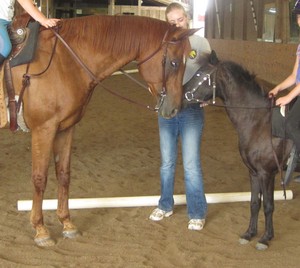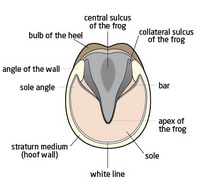Shoes or no shoes, hoof care is an important part of horse health

A horse who is ridden on a variety of surfaces including trails and show rings wearing shoes (note nail marks); a girl wearing tennis shoes; and an unshod pony.
Kathy Lundberg | Contributor
An important aspect of horse keeping is hoof care. The horse’s foot is the anatomic equivalent of our middle finger. The hoof is the fingernail, and the inner "frog" is the fingertip pad.
The function of the hoof is to bear the animal's weight to the ground and provide a durable surface for locomotion. A thousand pound horse’s weight is concentrated on four small footprints three to five inches in diameter.
The hoof wall must keep its structure under this weight, which is compounded by forces generated by the horses’ leg muscles striking the foot down, gripping the surface, and pushing off.
The famous horse-shoe shape is an ingenious way for the force to be spread out as much as possible to absorb the concussion of a footfall. Hooves may seem rigid, but they actually have considerable elasticity.

Horse hoof viewed from below.
Illustration courtesy of Mundo de Caballos
The frog is the triangular structure in the middle of the hoof, and this structure has important functions. It acts as a shock absorber in conjunction with the hoof wall. It helps provides grip so the horse has traction.
Also, the alternating compression and decompression of the frog with each step, along with the hoof wall’s slight flaring out and then contracting back to its unweighted shape, acts to pump the blood from the far reaches of the horse’s long legs back up the veins to its heart. Without these ancillary pumps, the heart would have difficulty circulating such a distance and against such a gravitational gradient.
Horse shoes support the hoof wall, helping prevent chips and cracks. Shoes elevate the more sensitive frog, limiting direct contact with the ground. They provide greater traction. Shoes also significantly limit the normal expansion/contraction of the hoof structures. This has implications for normal foot circulation, and may paradoxically make the hooves more brittle.
Like fingernails, hooves grow. They tend to grow faster in the warm spring and summer, and more slowly in the cold fall and winter. In nature, the horse moves over rough ground, filing and chipping the hoof wall down.
Most domesticated horses these days have cushier lives, and walk on more or less groomed, grassy, or well-trodden pastures. Many spend a significant portion of their lives in a stall, on packed dirt or rubber matting padded with bedding straw or wood chips.
This does not provide enough rasping action to self-trim, so people need to do this function. Domesticated horses and ponies generally need to have their hooves trimmed about every six to 10 weeks.
Why do some horses wear shoes and some do not? Which is better? A thorough treatment of the subject is beyond our scope here. The short answer is a function of physical characteristics and functional demands placed on the horse, as well human factors.
Some horses naturally have stronger hooves. Ponies are known for having good feet. Arabians, selectively bred for thousands of years, tend to have strong hooves. Mustangs, descended from Iberian horses mixed with a little of everything else that managed to cross the ocean and then the Americas, becoming feral along the way, naturally selected many hardy traits, including tough feet. Thoroughbreds (hot house flowers that they are) tend to have thinner hoof walls and to have more sensitive feet.
Within these broad breed generalizations are individual animals with better or lesser hoof quality.
Horses who tread very hard or rocky ground, or those who work strenuously many miles under saddle will put more wear and tear on their hooves. As a tree trunk that has always been supported will be less strong than a tree that has grown to bolster itself against the wind, a horse who has been exposed to hoof-hardening experiences and living conditions will have happier feet than one whose shoes were suddenly removed.
Shoes are specially made for different disciplines, such as the wide flat shoes for reining horses to slide on, the heavy shoes applied to saddleseat horses to encourage them to pick up their feet or the light shoes to give racers a sharper competitive edge. There are shoes for medical conditions such as navicular disease.
Some horses are shod only in front, where most weight is carried, and some are shod all around. Shoes can be hand-made from bars of metal, or purchased "off the shelf." They can be hot shod (heated to red-hot, shaped by hammer and anvil and burned onto the hoof wall for a nearly sealed fit), or cold shod (shaped at ambient temperatures by hammer and anvil or just nailed to hoof).
New techniques of gluing on shoes are being developed. There are also a myriad of horse boots now available, which can be put on and taken off like tennis shoes. Nailed-on or glued-on shoes and strapped on boots can come off, sometimes at most inopportune times.
As for human factors, there are people who never shoe their horses' feet, and there are those whose horses never go barefoot. In addition to health and functional concerns, there is the financial aspect. Shoes cost more than trims, hot shoeing costs more than cold, hand-made shoes generally cost more than store-bought shoes.
Farrier skills, experience, interests, and perspectives vary greatly. It is valuable to find a farrier with whom you can communicate, and with whom you share a basic philosophy of horse care.
Whichever method you choose, hoof care is an essential part of good horse-keeping. The adage "no foot, no horse" is largely true.
Kathy Lundberg is the owner of Scio Church Stables. Email her at scs@sciochurchstables.com.

